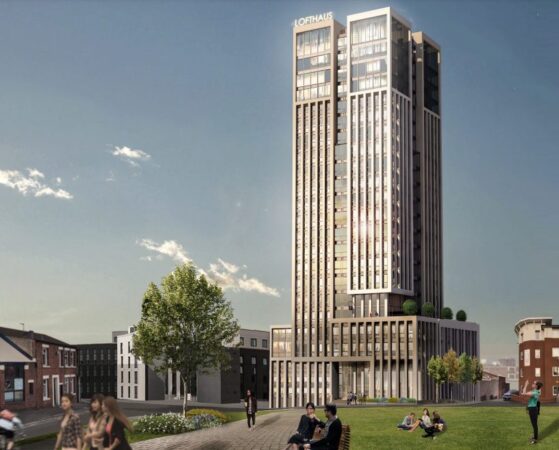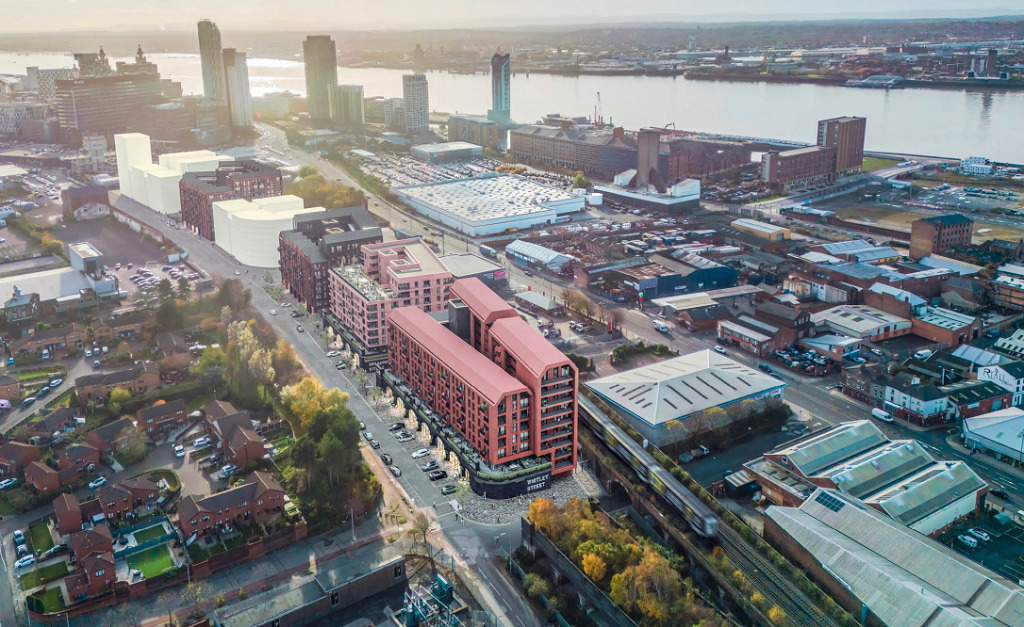The Subplot
The Subplot | Rishi’s rail row, Preston’s skyscrapers, server sheds
Welcome to The Subplot, your regular slice of commentary on the North West business and property market from Place North West.
THIS WEEK
- Towering ambition: Preston and the skyscrapers
- Northern Powerhouse Rail: Dead, or just sleeping?
- Data centres: The most valuable warehouse floorspace in the North West

AIMING HIGH

Preston’s potential skyscraper cluster
Preston-based Providence Gate wants to build the city’s tallest building on the corner of Patten Street and Great Shaw Street. Could the 30-storey hotel and apartment block be the start of a skyscraper cluster?
Providence Gate plans to replace Preston’s existing Foresters’ Hall student block with a 30-storey building containing 194 apartments and a 174-bed hotel. An application will be made to Preston planners next month for a contemporary tower designed “to reflect a modern and vibrant city in line with city living aspirations”, according to paperwork already submitted to the council.
A cluster, maybe?
“There is no reason why Preston should not aspire to the likes of Manchester and Salford,” a Providence Gate spokesperson responded when Subplot asked about a cluster. “It has the potential to be an important economic hub for the Lancashire region. We can’t see any reason why others would not follow suit – and we would certainly look at developing similar schemes within Preston provided this fell within the planner’s vision for the city.”
Funding
“As with all our projects, we always engage with potential funders we have established links with at a very early stage. We have already had detailed conversations regarding this project with funders and have had very positive feedback,” Providence Gate’s spokesperson added.
Local people
Providence Gate Developments and Providence Group Gate Holdings are controlled by Anthony Hayton. The company’s website claims £300m projects in progress, including a hotel in Abersoch and a business park in Leyland. During the summer, Providence Gate Developments registered a spate of new charges against assets, all of them to Birmingham-based crowd finance broker CrowdProperty.
Been here before
The site has history. An earlier version of the scheme promoted by ASSH Investments won consent in 2019, for what was described at the time as a £26m scheme of 21 storeys and 299 apartments. In 2017, Kingswood Properties had plans for a 20-storey student housing block. Both ASSH and Kingswood are controlled by Shoyab Mohammed Musa. Preston-based PWA Planning is the thread running through this: the firm advised ASSH, Kingswood and Providence Gate. The firm politely declined Subplot’s invitation to talk about a site that has occupied them for so long.
Green light
Preston planners seem to have no problem with the idea of taller buildings, even if the planning policy background is a bit thin. A Preston City Council spokesperson tells Subplot: “While we don’t have a specific tall buildings policy, we consider such applications in the context of our local plan design policies, the Central Lancashire Design Guidance and any masterplan supplementary planning documents that may be applicable. Tall buildings can be appropriate in a city centre like Preston and fit in with our city living aspirations, provided they are located in the right location, do not adversely affect our heritage assets and are of a high-quality design.”
More green lights
Private sector consultants agree that the scheme should have a smooth passage through to consent. Matthew Sobic, planning director at Savills Manchester, says: “The site benefits from permission for a 21-storey tower granted permission in 2019. Within that context, the additional height is unlikely to give rise to material changes in circumstance to matters already considered to be acceptable.”
Also red lights
The problem, if there is one, comes from those who have looked at Manchester’s experience and want to learn from the upsides and downsides of frantically developing towers. Too much reliance on overseas investor sales has its problems, they’ve concluded.
Not here, please
Wigan-based Heaton Group is behind plans for The Exchange, a 200-unit and 15-storey scheme in Preston, as well as an 11-storey scheme at Bishopsgate Gardens. Managing director John Heaton gives the strong impression that 15 storeys is tall enough. “I think it is crucial for Preston as a growing city that we, as developers, work with local businesses and independent brands to make sure the city remains authentic and retains its character, rather than us just building vertical communities or clusters that don’t work in years to come.”
Too soon
Heaton is not on his own. Danny Pinkus, partner at Robert Pinkus & Co, says: “We shouldn’t be craving skyscrapers. Demand for city living beds may well grow but it’s a small city centre and needs to be developed sensitively. Repurposing older builders is the way to do it, we don’t want to become another generic city.” There is also the question of timing in a still immature city living scene. “We’re right at the start of city living, and we’re probably a few years away from needing development at this scale,” he says.
The context
Preston looks like a busy city just now. Much-needed schemes like the £14.7m Friargate and Ringway regeneration proposals are now in hand and due for completion in spring 2023. Pillars’ 425-apartment, 160,000 sq ft student and keyworker accommodation Urban Hub scheme in Preston has now topped out, and the National Cyber Force decided to park itself down the road in a £5bn campus at Salmesbury and that trio was just October’s haul of good news. Yet skyscrapers take a lot of money, and some lucky timing, and the property industry consensus seems to be that moment has not yet arrived.
DRIVING THE WEEK
 Northern Powerhouse Rail, RIP
Northern Powerhouse Rail, RIP
The NPR high-speed rail plan failed to get a mention in Rishi Sunak’s budget last week (pictured, credit: Crown copyright), just as it failed to get a nod in Boris Johnson’s conference speech two weeks earlier. Are they building the tension, or is this a very bad portent?
Once is unfortunate, twice looks like carelessness. By failing to make two much-anticipated announcements on the high-speed Northern Powerhouse Rail project, the government has cast doubt on its commitment. The mood among the North’s Labour political leaders and ‘Red Wall’ Conservative MPs is cautiously pessimistic. The (probable) final date for giving the project a meaningful green light will come with the publication of the Integrated Transport Review, which rumour says is due on or around 11 November.
Boosterism
“Betrayal” some have cried, but betrayal feels like the wrong word because, to be fair to the government, it has never given more than casual off-the-cuff type commitments to Northern Powerhouse Rail. A single unexpected announcement by newly elected Prime Minister Boris Johnson in July 2019 that he supported the then £39bn project is the foundation of all subsequent enthusiasm. That speech was made in the midst of a political crisis with a general election looming, which ought to ring warning bells. Readers will, in any case, have different views on how far the Prime Minister’s utterances are to be taken seriously.
New money
On the other side, the government points out that Sunak announced a £6.9bn pot for regional transport, which is surely a sign of good intentions. ‘Not so fast’ said Bruntwood chief executive Chris Oglesby, who within minutes of Sunak concluding his Budget speech declared it to be “mostly a collection of existing announcements reheated for today.” Within the £6.9bn was £1.5bn of new money, spread over five years for all regional cities. So that’s £300m a year shared between Greater Manchester, Liverpool, Leeds and so on. In a government budget measured in trillions this is almost a rounding error – for context, Transport for Greater Manchester’s normal running costs are £173m a year. The extra pot will buy a few guided bus corridors, but don’t get your hopes up.
Bad vibes
Then there’s the politics. While Liverpool City Region councils and Metro Mayor Steve Rotheram are playing the old pragmatic game, and the Yorkshire cities are basking in governmental approval, the relationship between Greater Manchester and Whitehall has deteriorated. The hard-headed realism that dominated thinking from 1994/95 until the King of the North claimed his throne in 2020 hasn’t gone, it has just moved into the background where it continues to dominate official thinking. The problem is that politicians (Andy Burnham, Bev Craig, others) have adopted increasingly politicised (class) language which inevitably bleeds into the pragmatic business of getting things done. Subplot has spoken to senior insiders who worry that without good vibes between Greater Manchester and Whitehall the NPR project (and much else) is doomed. They are hoping to open back channels in which friendly dialogue can be resumed. It’s a nervous time.
Confused thinking
But if back channels are established, what do they talk about? Policy signals from Whitehall are hard to read. Michael Gove’s conference speech seemed to suggest intra- rather than inter-city connections are what really matter (see Subplot, 12 October). The logic in reducing Air Passenger Duty on short-haul internal flights is hard to grasp, and surely isn’t something you’d do if you were a great fan of high-speed rail, which the government says it is. The fear in Northern city halls is that the government will eventually fanfare backing for Northern Powerhouse Rail but what the government means by “Northern Powerhouse Rail” will not be what the cities mean. The outcome will be tinkering rather than a dedicated high-speed line.
Within the next couple of weeks we’ll know whether Sunak and Johnson have been adroitly building up the tension ready for a big ‘Go!’, or have been signalling ‘Stop!’ all along and Northern leaders didn’t have the leverage to change their minds.
IN CASE YOU MISSED IT…
The most valuable warehouses, ever
California-based Equinix says its 130,000 sq ft data centre at Salford’s Agecroft Commerce Park will be opening in a converted warehouse in early 2022. It is the latest in a growing regional cluster.
Data centres make the world wide web go round. They are the server-packed nodes that make the internet work. They have huge energy requirements, are full of vital infrastructure, and cost a packet to fit out (£61m in the case of Agecroft, which went to planners late last year). Greater Manchester is now the home to the largest regional cluster in the UK with nine centres (out of 45) operated by Teledata, UKFast and LDeX and another four by Equinix (in Manchester Science Park sites acquired from Telecity).
The property angle
We know a lot more investment is coming to meet habits formed during lockdown (more data means more data centres), and because European and UK data centre provision lags that of the US. Big investors like Blackstone spot an opportunity to make stonking returns. Local players like Legal & General are also active in this market through Kao Data. L&G teamed up with New Zealand-based data centre infrastructure business Infratil to develop its 15-acre, £500m data centre campus north of London. Even relatively small-time landlords get a chance to be involved because data centre locations and power capacity trump almost everything.
Data incoming
So far the portents are good. Nasdaq-listed Equinix has been on a roll: the share price has risen 20% in the last six months (13% over the last 12 months) as investors view it as one of lockdown’s winners. Recently it has been outperforming the market fairly consistently. Manchester could do the same: the transatlantic telecoms cables that make the internet work travel under Manchester, adding to the attractions of a city with the right labour force and lots of bandwidth-hungry tech businesses.
These things are measured in capacity, not floorspace. According to DCByte/Knight Frank over the summer the city had 133MW of capacity planned and in operation, with about 8MW vacant, which looks pretty tight. Knight Frank will be publishing updated regional data centre later this month which will show how fast things are changing. Subplot will report back.
The Subplot is brought to you in association with Cratus and Oppidan Life.






Who wants Preston to have tall buildings really? Ask that question and I think you get at whether it will benefit the city or not. And I think not. It’s a mistake if it happens. Successful things in Preston have happened because successful presentation, and attention to detail. Turning into Leicester isn’t going to help those efforts.
Re NPR, Whitehall and GM, personally I think the falling out is healthy for the UK. In a supposed democracy, what word describes a situation where secret plans and favours are forged in closed doors relationships. Where one city receives more than its fair share while others are shunned, and reasons are contrived to keep that the case.
The outcomes for the UK from the Osborne era haven’t been good, and in fact are proving incredibly costly in so many different ways.
By Jeff
Re the Bad Vibes, it has seemed obvious for years that the Tories have tried to prise Manchester from Labours grasp by shovelling loads of money at it but it hasn`t worked , so it looks like now it`s Leeds`s turn to be favoured ,especially by Rishi.
It`s a sad way to govern a country, ie favouritism,as it leads to inequality and grievance, remember a few years back when Nick Clegg was deputy PM, he was winning promises for Sheffield but when the coalition folded most were dropped eg Sheffield rail electrification.
All our great Northern cities, Leeds, Liverpool,Manchester, Sheffield need the same investment so the region benefits as one , and not just selected bits prospering.
By Anonymous